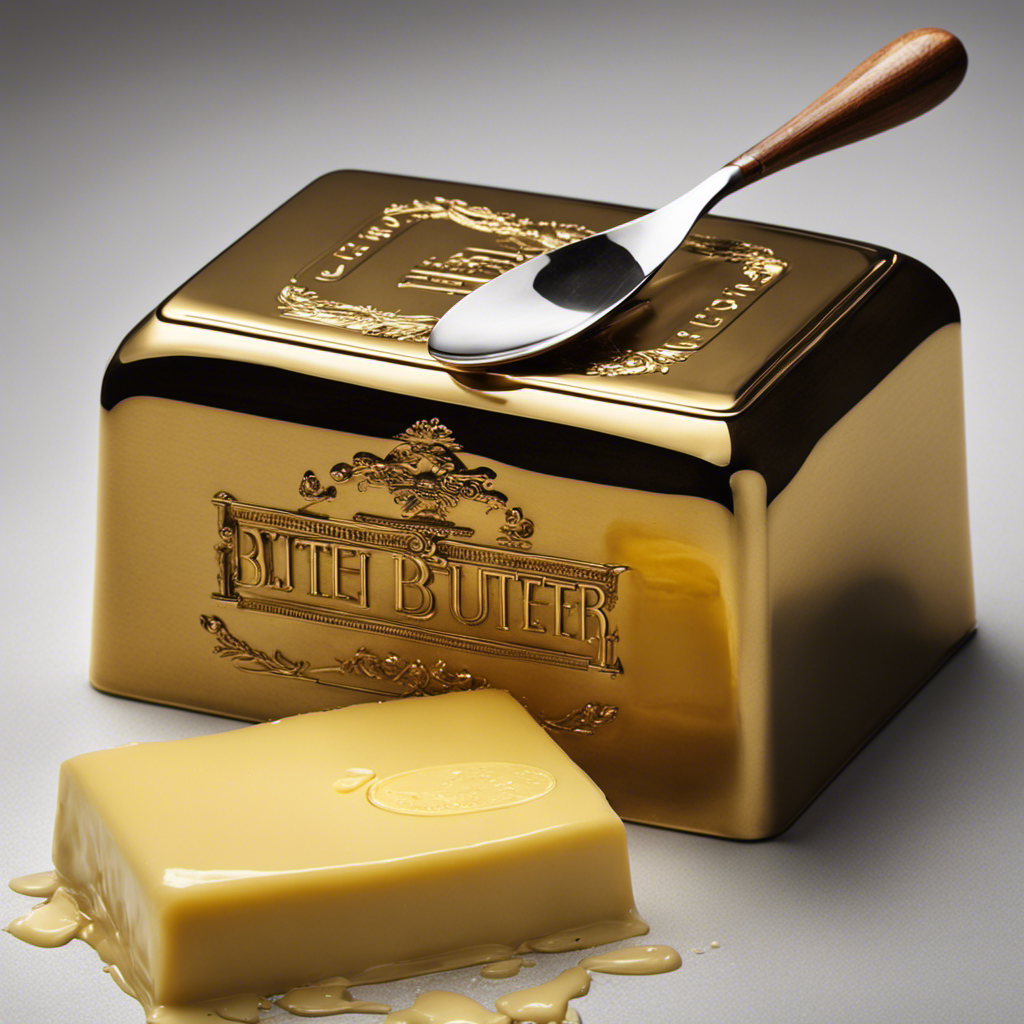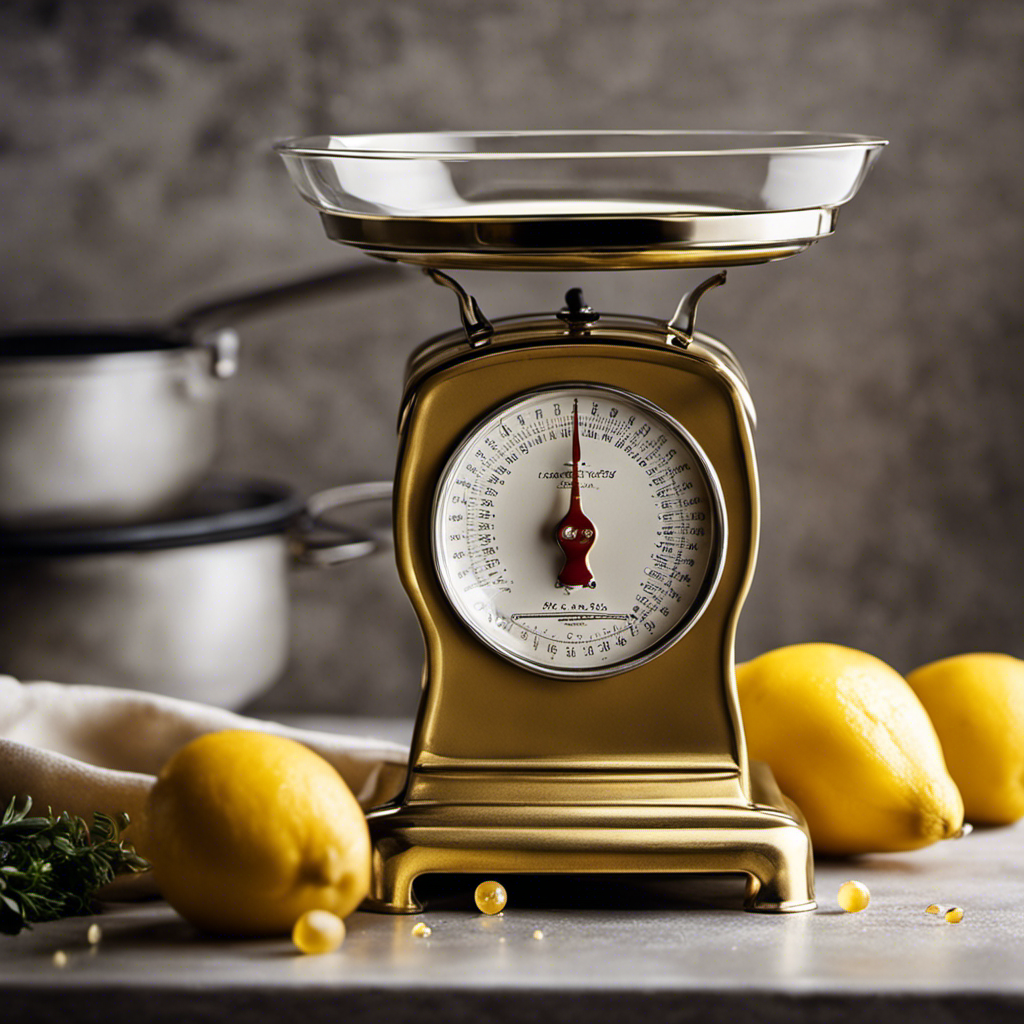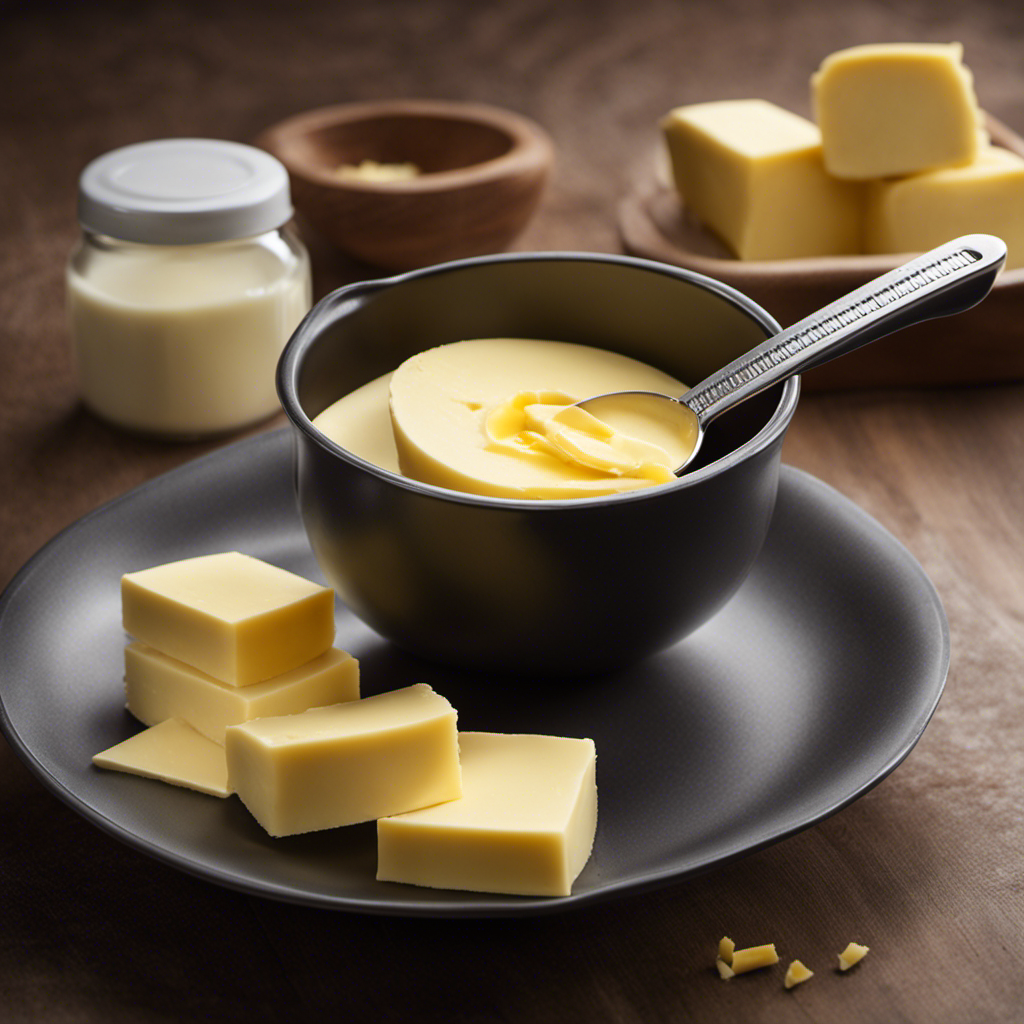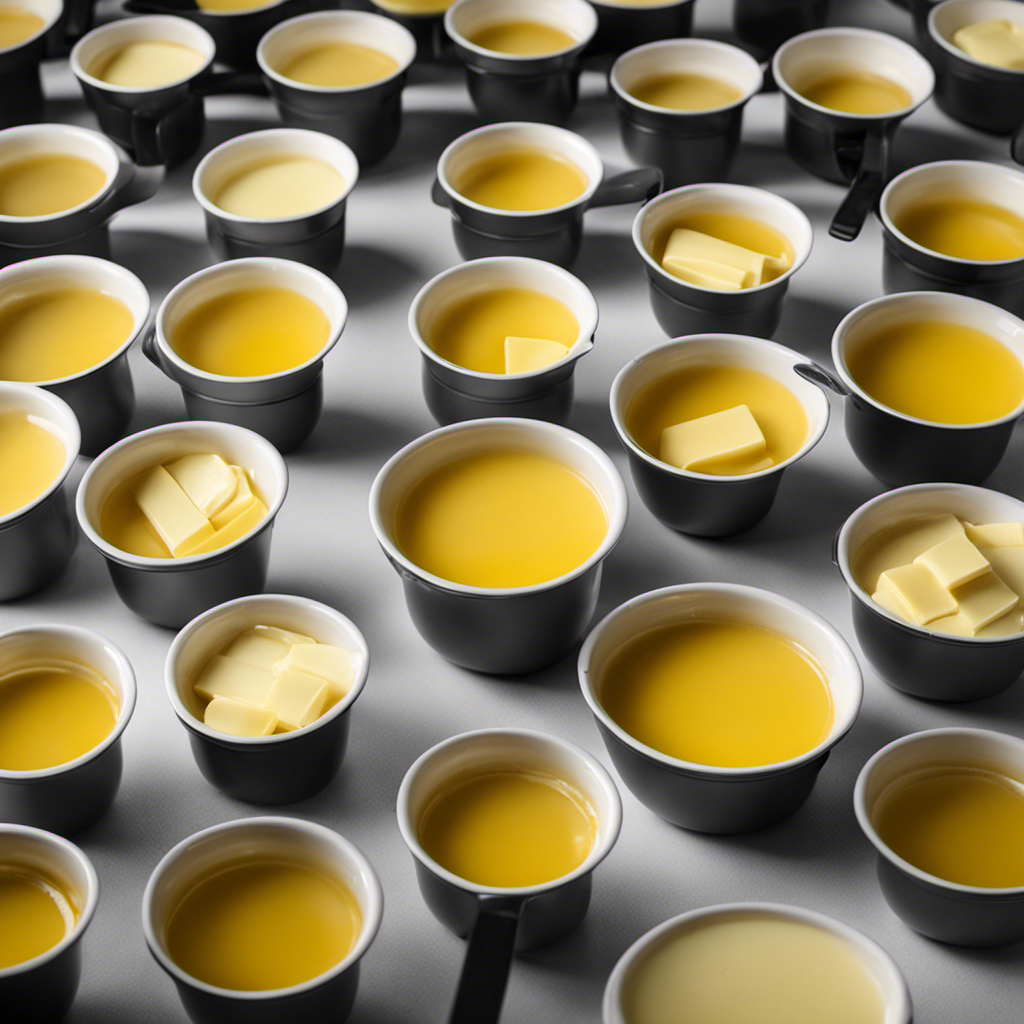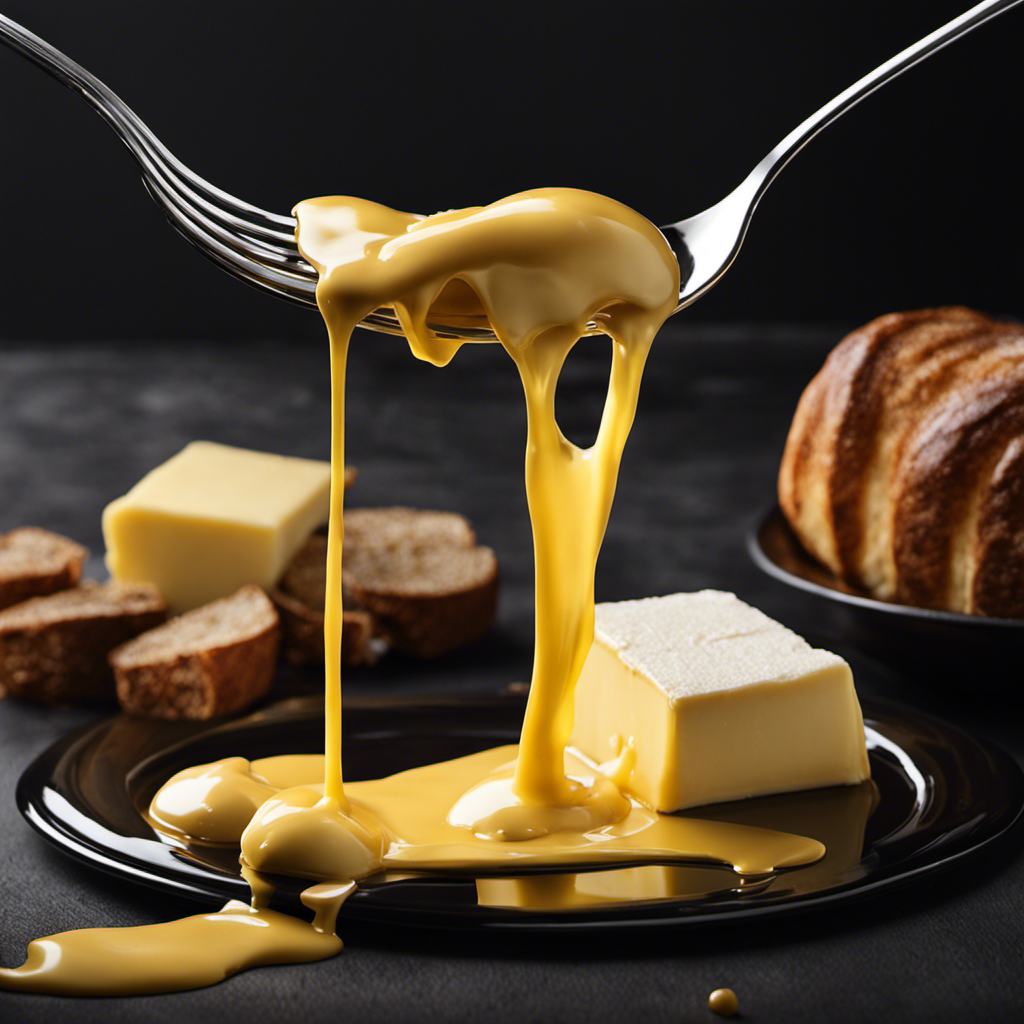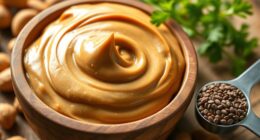As someone who has a passion for butter, I’ve frequently pondered the value of one pound of this smooth treasure. In our discussion today, we’re going to explore the realm of butter quantities, culinary uses, and even take a look at some price evaluations.
Prepare to have your taste buds tantalized as we uncover the secrets behind the versatile pound of butter. So grab a slice of toast, sit back, and let’s unravel the mysteries of this golden treasure.
Key Takeaways
- 1 pound of butter is equal to 4 sticks or 2 cups in the United States.
- Each stick of butter weighs 1/2 cup or 113 grams.
- In Europe and other metric system countries, 1 pound of butter is approximately 454 grams.
- Butter can be used for browning meats and vegetables, in sauces and gravies, and for baking pastries, cookies, and cakes.
Different Measurements for 1 Pound of Butter
There’s a few different measurements for 1 pound of butter, depending on the region. In the United States, 1 pound of butter is equal to 4 sticks or 2 cups. Each stick weighs 1/2 cup or 113 grams.
However, if you’re in Europe or other countries that use the metric system, 1 pound of butter is equal to approximately 454 grams. This conversion is useful when following recipes that require precise measurements.
It’s important to note that if you don’t have butter on hand or are looking for a healthier alternative, there are various butter substitutes available. These substitutes include margarine, oil, yogurt, or even applesauce, depending on the recipe.
Now, let’s dive into the metric conversions for 1 pound of butter.
Metric Conversions for 1 Pound of Butter
Converting 1 pound of butter to metric units, it’s approximately 0.45 kilograms.
When it comes to converting butter measurements from metric to imperial units, it’s important to understand the conversion factor.
To convert kilograms to pounds, you simply multiply the weight in kilograms by 2.20462.
So, if you have 0.45 kilograms of butter, you can multiply it by 2.20462 to get the equivalent weight in pounds, which is approximately 0.9921 pounds.
This conversion is useful when following recipes or when you need to convert butter measurements from one system to another.
Culinary Uses for 1 Pound of Butter
If you’re a fan of rich and creamy dishes, 1 pound of butter can be used to create a wide variety of delectable culinary delights. Here are some culinary techniques and recipe ideas to make the most of that pound of butter:
-
Browning: Use melted butter to brown meats or vegetables, adding a rich and nutty flavor to your dish.
-
Sauces and gravies: Butter is a key ingredient in many classic sauces and gravies, adding richness and depth of flavor.
-
Baking: Butter is essential for creating tender and flaky pastries, cookies, and cakes. From pie crusts to buttercream frosting, butter adds both flavor and texture.
By incorporating these culinary techniques and recipe ideas, you can create a wide range of delicious dishes using just 1 pound of butter.
Butter Alternatives for 1 Pound Recipes
To explore alternative options for your 1 pound recipes, you can try using different substitutes for butter. There are several butter substitutes available that can be used in vegan or dairy-free recipes.
One popular option is vegan butter, which is made from plant-based oils like coconut or olive oil. Vegan butter has a similar texture and taste to regular butter, making it a great substitute in recipes that call for butter.
Another option is using coconut oil, which adds a rich flavor to baked goods and can be used as a 1:1 replacement for butter.
Other alternatives include applesauce, mashed bananas, or even avocado. These options provide moisture and texture to your recipes while reducing the amount of fat.
Now that we’ve explored butter substitutes, let’s move on to the next section about storing and preserving 1 pound of butter.
Storing and Preserving 1 Pound of Butter
When it comes to storing and preserving butter, it is essential to understand the proper butter storage techniques, the different preservation methods available, and the longevity of stored butter.
Proper butter storage involves keeping it in an airtight container in the refrigerator to prevent it from absorbing odors and flavors.
Additionally, butter can be preserved by freezing it, either in its original packaging or wrapped tightly in aluminum foil or plastic wrap.
The longevity of stored butter varies depending on the preservation method used, but generally, refrigerated butter can last for several weeks, while frozen butter can remain good for up to six months.
Proper Butter Storage
Make sure you store your butter in an airtight container to keep it fresh. Proper butter storage is essential to maintain its quality and prevent spoilage.
Here are some butter preservation techniques that can help prolong its shelf life:
-
Store butter in the refrigerator: Butter should be kept in the refrigerator at a temperature of around 40°F (4°C) to slow down the process of oxidation and rancidity.
-
Use a covered butter dish: If you prefer to keep your butter at room temperature for easy spreading, use a covered butter dish to protect it from exposure to air and contaminants.
-
Wrap butter tightly: If you buy butter in bulk or want to freeze some for later use, wrapping it tightly in plastic wrap or aluminum foil can help prevent freezer burn and maintain its freshness.
Following these proper butter storage techniques will ensure that your butter stays fresh and flavorful for longer periods.
Butter Preservation Techniques
If you want to extend the shelf life of your butter, try storing it in an airtight container. This is one of the best butter storage methods that can help preserve its freshness and prevent it from going bad quickly.
Butter preservation techniques involve keeping it away from light, heat, and air, which can cause it to spoil faster. By sealing it in an airtight container, you create a barrier that protects the butter from exposure to these elements. It is also important to keep the butter refrigerated at a stable temperature to maintain its quality.
Additionally, using butter keepers or butter dishes with lids can also help in preserving the butter’s flavor and texture. With these butter preservation techniques, you can enjoy longer-lasting butter that stays fresh and delicious.
Transition: Now that you know the best butter storage methods and preservation techniques, let’s explore how long stored butter can actually last.
Longevity of Stored Butter
Storing butter in an airtight container helps extend its shelf life and maintain its freshness. When it comes to long term storage methods for butter, there are a few best practices that can ensure its longevity.
Here are three key points to consider:
-
Keep it in the refrigerator: Butter should always be stored in the refrigerator, as it helps slow down the process of oxidation and keeps it fresh for a longer period of time.
-
Wrap it properly: To prevent the butter from absorbing unwanted odors or flavors, wrap it tightly in wax paper or aluminum foil before placing it in the airtight container.
-
Use salted butter: Salt acts as a natural preservative, so using salted butter instead of unsalted can help prolong its shelf life.
Exploring the Cost of 1 Pound of Butter
The cost of 1 pound of butter varies depending on the brand and location.
There are different types of butter available in the market, such as unsalted, salted, cultured, and clarified butter. Each type has its own distinct flavor and texture, making them suitable for different recipes.
Butter is a versatile ingredient that adds richness and depth to dishes. It enhances the flavor of baked goods, adds creaminess to sauces, and creates a beautiful golden crust on meats and vegetables.
Using butter in recipes also provides nutritional benefits, as it contains essential vitamins and minerals. However, it is important to use it in moderation due to its high fat content.
When shopping for butter, it is recommended to compare prices and consider the quality and taste that each brand offers.
Frequently Asked Questions
What Is the Nutritional Value of 1 Pound of Butter?
The nutritional value of 1 pound of butter is high in saturated fat and calories. While it provides some essential vitamins, it also poses health risks, such as increasing cholesterol levels and the risk of heart disease.
Can I Use Margarine as a Substitute for 1 Pound of Butter in Recipes?
Yes, you can use margarine as a substitute for 1 pound of butter in recipes. It provides a similar texture and taste. However, keep in mind that margarine may have different health benefits compared to butter.
How Long Will 1 Pound of Butter Last in the Refrigerator?
In my experience, 1 pound of butter can last in the refrigerator for about 2-3 weeks if stored properly. To make the most of leftover butter, I recommend incorporating it into various recipes or spreading it on toast.
Can I Freeze 1 Pound of Butter for Long-Term Storage?
Yes, you can freeze 1 pound of butter for long-term storage. Freezing butter preserves its freshness and extends its shelf life. Alternatively, you can also consider using butter alternatives if you prefer not to freeze it.
What Is the Average Cost of 1 Pound of Butter?
The average price of 1 pound of butter varies depending on the location and brand. However, there are butter alternatives available such as margarine or ghee that can be used as substitutes.
Conclusion
After exploring the different measurements, culinary uses, and alternatives for 1 pound of butter, it is clear that this ingredient is a staple in many recipes.
However, one interesting statistic to note is the cost of 1 pound of butter. On average, a pound of butter can range anywhere from $2 to $5, depending on the brand and quality. This highlights the importance of budgeting and considering alternatives when using butter in larger quantities.
So next time you’re in the kitchen, keep in mind the value of 1 pound of this creamy and versatile ingredient.
